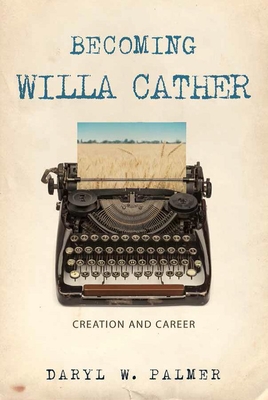 Becoming Willa Cather: Creation and Career
Becoming Willa Cather: Creation and Career
by Daryl Palmer
University of Nevada
264 pages, $39.95
A PHOTOGRAPH taken in 1895, now in the archives of the Nebraska State Historical Society, shows three people—two young women and a boy—posing with their bicycles. One of the young women, sporting a necktie and cowboy boots, is the 21-year-old Willa Cather, a newspaper columnist fresh out of college. As he contemplates this photo, Daryl Palmer, a professor of English at Denver’s Regis University, sees a young woman who is “confused, confident, childlike, wired for self-preservation, skeptical, prone to fits of exertion and bouts of exhaustion, pragmatic, sarcastic, hyperbolic, and romantic.”
That’s a lot to find in a faded snapshot, but Palmer is intent on telling the story of how “this woman on the wheel,” a girl raised in a small prairie town, became a major novelist in the American literary canon. That story is intimately connected to Cather’s years in Nebraska.
Cather was captivated by the “townmaking” enterprise in the late 19th-century Republican River Valley. In particular, Red Cloud, the Nebraska town to which she and her family moved when she was ten, was a more dynamic place than is normally depicted. While many scholars assume that Cather’s achievements as a writer stemmed from her “genius triumphing over place,” Palmer emphasizes the vitality, rather than the dreariness, of prairie towns like Red Cloud. “The energy of creation was everywhere,” he writes.
The life of the town was exciting and worth writing about, Cather discovered. More broadly, what she was constantly discovering, Palmer says, were “new ways of imagining the West.” During her literary apprenticeship, she reimagined the American West while “reflecting on cherished notions of gender, prairie, love, friendship, imagination, and economics.” As she once told one of her reviewers, she aimed to show that “the cow-puncher’s experience of the West was not the only experience possible there.”
 Palmer is especially good at digging deeper into Cather’s early stories, which have too often been dismissed or treated as journeywork by past critics. In a story like “Tommy, the Unsentimental” (1896), Cather presents a heroine who has no intention of settling into domestic life or responding to a male suitor. It is a story that eases the reader “into a fictional world where gender and identity are fluid and obliquely erotic.” Cather was asking whether a woman’s work could ever count the same as a man’s work.
Palmer is especially good at digging deeper into Cather’s early stories, which have too often been dismissed or treated as journeywork by past critics. In a story like “Tommy, the Unsentimental” (1896), Cather presents a heroine who has no intention of settling into domestic life or responding to a male suitor. It is a story that eases the reader “into a fictional world where gender and identity are fluid and obliquely erotic.” Cather was asking whether a woman’s work could ever count the same as a man’s work.
In charting Cather’s emergence as a literary artist, Palmer leans heavily on the theories of creativity propounded by Henri Bergson, whom Cather had read. According to Bergson, each of us is an “artisan.” We are continually creating ourselves, our personalities, our understanding of what it means to be in the world. For Cather, this process of creative emergence involved “three crucial elements—memory, imagination, and craft.”
Palmer links these three crucial elements (which, to my mind, describe how any great writer pursues her craft) to Cather’s way of using her experience, which he identifies with a neologism: the “palimpsestuous imagination.” He sees Cather taking up experiences, memories, and texts (especially newspaper accounts) and intricately interweaving and repurposing them to fashion the stories and the vision of human life that suited her. She wanted “the freedom to write honestly about different phases of settlement and the settlers’ recollections of their experiences.”
The jacket flap that accompanies Palmer’s book touts Cather as “a compelling figure in the literary history of lgbtq America,” but readers looking for a thoroughgoing examination of Cather’s sexuality will be disappointed. (Sharon O’Brien’s 1987 study, Willa Cather: The Emerging Voice, is the place to go for that.) Nevertheless, Palmer does emphasize that Cather’s personal and literary journey was always about a search for an authentic depiction of life that pushed back against the masculine tropes that dominate the literature of the American West. Cather’s stories “encouraged people to … imagine the world and themselves—otherwise.” She invited her readers to explore notions of gender fluidity, implying—long before it was fashionable—that notions of masculinity and femininity are only social constructions.
By 1913, with the publication of O Pioneers!, Cather had emerged as a major American author. But her journey was far from over. She would go on to write her masterpiece, My Ántonia (1918), and several other fine works. Indeed, Cather never stopped trying to create an enduring portrait of the West. “Her desire for experimentation was indomitable,” Palmer says in concluding this valuable addition to Cather studies.
Philip Gambone, a regular contributor to these pages, taught fiction writing at the Harvard Extension School for over 25 years.






